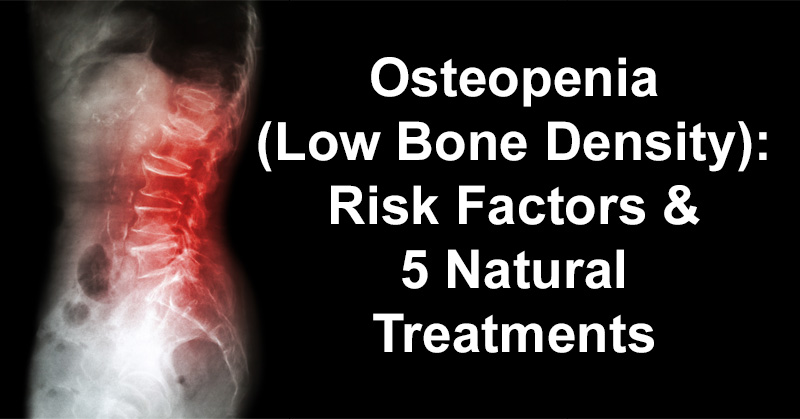Osteopenia, or low bone density, is a condition wherein you have lower bone density than normal. Bone mineral density, or BMD, is the measurement used to find out how much bone mineral is in your bones. And although having a low BMD means you have osteopenia, the condition itself is not a disease. There are a variety of risk factors and possible causes of osteopenia, such as malabsorption and poor diet. As such, osteopenia treatment and low bone density treatment involves lifestyle changes. A low bone density diet is necessary in order to ensure you are getting the right nutrients. For more information on this condition and how to treat it, read below. (1, 2)
Low Bone Density Symptoms and Risk Factors
Low bone density causes might include a lack of proper nutrients or malabsorption of nutrients, as caused by such conditions as Celiac disease. Underlying issues such as this may have its own set of symptoms.
Other risk factors for osteopenia include: (3)
- Aging
- Early menopause (before age 45)
- Surgery to remove ovaries before menopause
- Sedentary lifestyle
- Smoking or tobacco use
- Alcohol abuse
- Eating disorders such as anorexia nervosa and bulimia
- Hyperthyroidism, which is either from an overactive thyroid or from taking too much medicine to treat this condition
Low bone density symptoms for the condition itself aren’t typical, however, as osteopenia itself doesn’t usually cause any pain. However, low bone density causes, at times, bones to fracture, but not in every case.
While there aren’t usually low bone density symptoms with osteopenia, there are other conditions that can develop from it, such as osteoporosis, which has its own set of symptoms:
- Fractures
- Stooped posture
- Severe pain (healthline)
Here are 5 natural low bone density treatment methods:
1. Low Bone Density Diet

A crucial part of osteopenia treatment is a proper diet. Be sure your meals contain an adequate amount of calories as well as the right nutrients. In particular, calcium and vitamin D are paramount when it comes to supporting bone health.
Other important nutrients you need to prevent bone disorders include iron, vitamin C, and magnesium. Anemia can develop as a complication from osteopenia because iron is essential for collagen synthesis and vitamin D metabolism. (4, 5)
- Foods that provide calcium include: dark leafy green vegetables; and other veggies like broccoli.
- Examples of magnesium rich foods include: leafy greens such as chard or spinach, pumpkin seeds, kefir, black beans, cocoa and almonds.
- Foods rich in Vitamin C include: citrus fruits, papaya or guava, berries, peppers, kiwi, broccoli and kale.
- Sources of iron include: nuts, seeds, spinach, kale and chard.
The bottom line is, aim for an alkaline diet that helps protect the bones. This translates to several vegetables, fruit, sea vegetables and plant foods. Watch your sodium intake and stay away from processed and packaged foods. Furthermore, limit your intake of sugary products, alcohol and caffeine.
2. Include Osteopenia Exercises

Exercise is also an important component of osteopenia treatment. It helps reduce the decline is bone mass associated with aging. It can also help you improve balance, which leads to a decreased risk of falling and fracturing a bone.
Weight-bearing exercises are the most beneficial method of exercise for low bone density treatment. This is the type of exercise that forced you to work against gravity. Doing so forces your bones and muscles to support your body weight. (6) Running, walking, dancing, skiing or tennis are all good options. Do them as much as you can without overtaxing your body. Aim for roughly 3 to 4 times a week for 0 to 60 minutes at a time. Additionally, try some weight training exercises, using your own body weight, free weights, or resistance bands.
3. Take Supplements That Can Help Protect Bones
You may not always get enough nutrients through the food you eat. As part of your osteopenia treatment, take the following supplements to ensure you’re getting enough of what you need:
- Calcium — As a rule, it’s best to consume calcium in the foods you eat. However, if you know you’re not getting enough, you can take a supplement. Most adults need roughly 1,000 milligrams of calcium a day. Be sure you choose calcium citrate, which is the kind the body absorbs the best.
- Vitamin D — It seems many people have a vitamin D deficiency. If you never spend time outdoors, have dark skin, have a history of deficiency, or are elderly, you should consider taking a vitamin D supplement. Try for 1,000 IU of vitamin D per day. However, older adults may need higher amounts.
- Magnesium — Your body requires magnesium for proper calcium metabolism. Consume between 300–500 milligrams daily.
- Vitamin B12 — Due to changes in digestion, elderly people in particular may have a difficult time with food sources of this vitamin. Also, vegans and vegetarians may not be getting enough B12.
- Vitamin K2 — Vitamin K2 is crucial for forming a protein your body needs for bone formation. You need vitamin K2 to form a protein that’s critical for bone formation. Take about 100 micrograms daily.
4. Maintain a Healthy Weight
Obesity can increase inflammation, as well as contribute to hormonal changes that lead to bone damage. As such, maintaining a healthy weight can be a helpful part of an osteopenia treatment plan. Doing so makes it easier to exercise and stay active into older age.
5. Get Enough Sunlight

Vitamin D aids in calcium absorption, and as such, it’s an important part of low bone density treatment. While you can take supplements, it’s best to get your vitamin D from natural sunlight. If you’re able, get 15 to 20 minutes of sunshine exposure on your bare skin daily.


